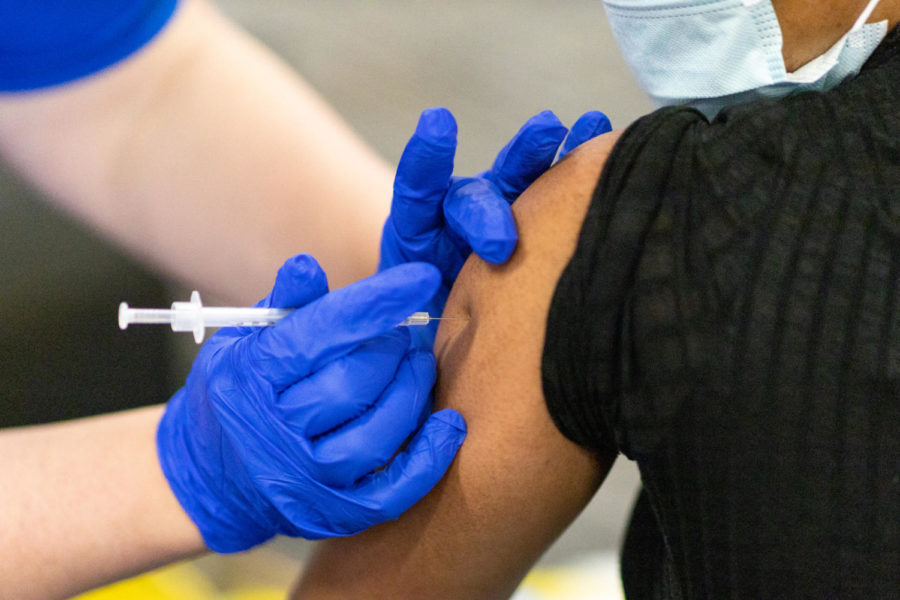UK discontinues COVID dashboard as Kentucky positivity rates increase
A dose of the Pfizer COVID-19 vaccine is injected into a patient’s arm on Saturday, April 10, 2021, at UK’s COVID-19 vaccination clinic at Kroger Field in Lexington, Kentucky. Photo by Jack Weaver | Kentucky Kernel
September 1, 2022
The University of Kentucky is no longer maintaining a COVID-19 dashboard displaying vaccination percentages and positivity rates among students, faculty and staff.
The dashboard, which was updated regularly since its creation in September 2020, included campus-wide statistics for total active COVID cases, total recovered cases, total new cases, number of students in isolation and percentage of vaccinated individuals.
The information was publicly available on UK’s coronavirus website but is now password protected – and students’ and faculty members’ linkblue ID information does not grant them access.
This comes as UK welcomes the largest incoming freshman class in university history, with over 6,000 first-year students joining the campus community.
UK spokesperson Jay Blanton told the Kernel in an email that the dashboard will not be published “at the institutional level.”
“We are moving from a status of responding to the pandemic to continual management of a transmissible virus, much like the flu and other public health issues that will require community support,” Blanton said.
While Blanton said that this move is in accordance with what other institutions are doing, the University of Michigan and Cornell University continue to publish data regularly, and institutions like Ohio State (which paused its reporting over the summer) and Michigan State (which only publishes self-reported data) also offer some form of COVID numbers.
Blanton said that Lexington “discontinued its dashboard in favor of the state dashboard” in response to the CDC’s reporting scheme.
However, the Lexington Fayette County Health Department continues to publish new and total case and death numbers from Lexington on its website, updating the information weekly. As of Aug. 29, there were 887 new cases and two deaths in Fayette County, adding to the totals of 111,402 total cases and 654 total deaths – contributing to a state-wide weekly positivity rate of 20.07%.
As of Aug. 26, 74 of the 120 Kentucky counties had a COVID-19 community level of high, according to the CDC.
Blanton said the decision to stop maintaining the dashboard was also a result of UK’s move away from mandatory testing.
“We don’t require either testing or vaccination as both can now be widely found in other places, so we don’t have one rigorous source of information for vaccine rates in our community,” he said.
In an interview with the Kernel, UK president Eli Capilouto called dashboards “not meaningful and helpful,” as he said people can test at home and are not obligated to self-report positive results.
“There’s really no way to calculate [a positivity rate] today that is entirely meaningful with self-testing especially,” he said. “So public health departments do not recommend surveillance testing, like we were doing before, when you have … 90% of your campus vaccinated, and we know from our hospital cases and those around the commonwealth that the virus is under reasonable control.”
However, the 90% vaccination rate was reached in December 2021, before the 6,000 new students arrived on campus this fall.
Capilouto also called efforts to screen UK’s population for monkeypox “unnecessary [and] unfounded,” adding that the university will rely on the public health department to keep track of cases.
Blanton said that the university is asking students, faculty and staff to continue vaccinating and self-reporting, adding that UK will be offering incentive programs to encourage vaccinations.
“The moves we have made continue to be in alignment with the latest CDC recommendations,” he said. “Further, our COVID operations and START teams will continue to meet on a regular basis to monitor our response to this virus and be ready to pivot should that be necessary.”





















































































































































Kaitlyn • Sep 4, 2022 at 9:16 am
yikes